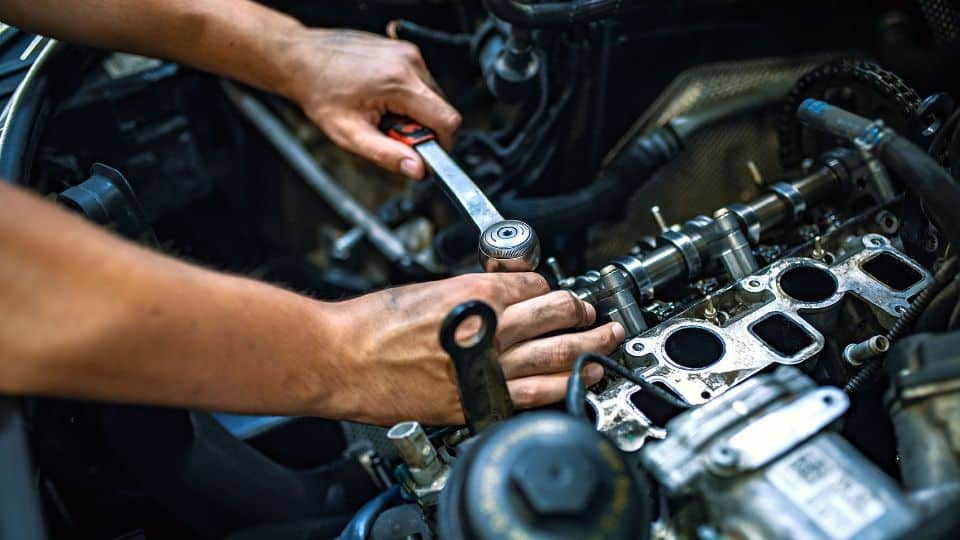What is the name of this car part?

Engine
Battery
Alternator
Starter
Car Parts Quiz
Taking a car parts quiz is a great way to learn about a vehicle’s inner workings and test your knowledge and understanding of different parts and systems. Whether you’re an experienced mechanic or a curious car enthusiast, the information you learn can be applied to a wide range of situations, from maintaining and repairing your car, to helping others with their vehicles and much more.
A car parts trivia quiz is a great way to test your knowledge and expand your understanding. Take the quiz now, and see how much you can learn about the fascinating world of cars!
Example of Car Parts
Car parts can be divided into several categories, including mechanical components, electrical components, and body parts. Some common examples of car parts include:
- Engine components: such as cylinders, pistons, crankshaft, camshaft, valves, and fuel system.
- Transmission: responsible for transmitting power from the engine to the wheels.
- Suspension: includes the shocks, springs, and control arms, which help to absorb bumps and vibrations in the road.
- Electrical components: such as the battery, alternator, starter motor, and spark plugs which help to power the vehicle and control various systems.
- Braking system: includes the brake pads, rotors, calipers, and master cylinder, which are responsible for slowing down and stopping the vehicle.
- Steering and suspension: includes the steering wheel, tie rods, ball joints, and rack and pinion, which help to steer the vehicle and maintain proper control.
- Body parts: such as the doors, hood, fenders, and bumpers which protect the occupants of the vehicle and give the car its unique look and style.
- Interior components: such as the seats, dashboard, and carpets, which provide comfort and convenience for the passengers.
These are just some of the few examples of the many different car parts that make up a vehicle. Understanding how each component works and how they interact is crucial for maintaining and repairing your car and ensuring its safe operation on the road.
Important Car Parts
- Engine: The engine is the heart of the car and is responsible for generating power to move the car. It converts fuel into mechanical energy and powers the car’s wheels.
- Transmission: The transmission is responsible for transmitting power from the engine to the wheels. It allows the car to change gears and adjust speed.
- Brakes: Brakes are responsible for stopping the car and keeping it under control. They work by using friction to slow down or stop the car’s wheels.
- Suspension: The suspension system is responsible for absorbing shock and providing a comfortable ride. It consists of springs, shock absorbers, and other components that help cushion the car from bumps and vibrations.
- Steering: The steering system is responsible for controlling the direction of the car. It allows the driver to turn the car left or right and keep it on course.
- Battery: The battery is responsible for providing power to the car’s electrical system. It stores energy and provides power to start the engine and operate the car’s lights, radio, and other accessories.
- Ignition system: The ignition system is responsible for starting the engine. It consists of components such as the battery, starter motor, and spark plugs that work together to ignite the fuel and start the engine.
- Fuel system: The fuel system is responsible for delivering fuel to the engine. It includes components such as the fuel pump, fuel injectors, and fuel lines that work together to provide the engine with the fuel it needs to run.
- Exhaust system: The exhaust system is responsible for removing the waste gases produced by the engine. It consists of components such as the muffler, catalytic converter, and exhaust pipe that work together to reduce emissions and noise.
- Tires: Tires are responsible for providing traction and stability while driving. They are the only part of the car that makes contact with the road and play a critical role in maintaining control of the car.
Fun Facts About Car Parts
- The first car with four-wheel hydraulic brakes was the Duesenberg Model A in 1921. It had a top speed of 85 mph and cost $8,500, which was an astronomical sum at the time.
- The first windshield wipers were hand-operated by the driver or passenger. They were invented in 1903 by Mary Anderson, who was inspired by the difficulty of driving in a snowstorm.
- The catalytic converter, which reduces the emissions from a car’s exhaust, was invented in the 1950s by French engineer Eugene Houdry. It was first used in cars in the 1970s in response to growing concerns about air pollution.
- The world’s first pneumatic tire was invented by John Boyd Dunlop in 1888. It was made of rubber and filled with air, which provided a much smoother ride than the solid tires that were previously used.
- The alternator, which generates electricity to power a car’s electrical system, was invented in the 1960s. Before that, cars used generators, which were less efficient and more prone to failure.
- The first automatic transmission was invented by Canadian engineer Alfred Horner Munro in 1921. It was called the “Hydra-Matic” and was first used in the 1940 Oldsmobile.
- The first car radio was invented by Paul and Joseph Galvin in 1930. They named their company Motorola, which is a combination of the words “motor” and “Victrola,” a brand of phonograph.
- The world’s first car horn was invented by Oliver Lucas in 1910. It was originally called the “Klaxon” and was operated by squeezing a rubber bulb.
- The first car headlights were introduced in 1898. They were powered by acetylene gas and were manually operated by the driver or passenger.
- The world’s first electric starter was invented by Charles Kettering in 1911. It eliminated the need for a hand crank, which was difficult and dangerous to use.



